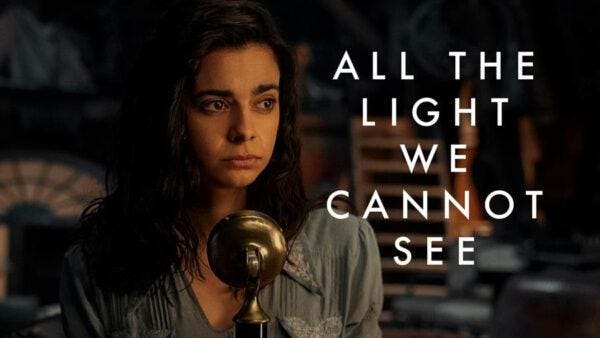I’ve known him only a few years, but my ties to Joe Strechay are strong.
First and foremost, we’re both members of the Blind and low vision community. Second, I first learned about him in 2019 when, while covering Apple’s glitzy media event at Apple Park where the company launched Apple TV+ and other services, I learned he was the accessibility consultant on one of TV+’s original launch series See. Some time later, in August 2021, I interviewed Strechay for this column about his involvement with See and what the show’s heavy emphasis on blindness meant for disability representation on film and television.
In November 2023, Strechay once again hits this space’s spotlight.
I recently sat down with Strechay via videoconference to discuss his work in consulting for the new Netflix limited series All The Light We Cannot See, which premieres today on the streaming service. The series, which is only four episodes long, is based on Anthony Doerr’s 2014 bestselling book about a Blind girl named Marie-Laure (played by Aria Mia Loberti) who, while hiding out in her uncle’s home in Nazi-occupied France in 1943, forges an unlikely connection with German soldier Werner Pfennig over their shared fascination with radio technology.
Netflix has an audio-described trailer for the show on YouTube.
Newsweek published an “exclusive look behind-the-scenes” of the show.
Strechay, who’s credited as an associate producer, was succinct in his enthusiasm for All The Light We Cannot See, saying working on it was “kind of like a dream.” What’s different about it from other projects he’s worked on, where the aforementioned See and the superhero series Daredevil were rooted in science fiction, All The Light We Cannot See is “based in reality.” It’s a period piece, rooted in a historical event, that Strechay said was fun and challenging to “work within that and create accessibility.” A big aspect of his job is figuring out what the actors and the production may need; this included tape on the floor (for first or last mark) or scripts in an accessible format like Braille. Strechay was praiseful of Loberti, telling me working with her was a terrific experience and it was “amazing to see the growth in her” during shooting. Moreover, he called her “a brilliant person and quick study” and “an amazing actor” who, despite her inexperience, held her own alongside “some of the best actors in the world” in Mark Ruffalo and Hugh Laurie.
As to how Strechay actually gets his job done, he shared that he has a sighted assistant with him on every set whose job it is to audio describe what’s going on, in the exact same vein All The Light We Cannot See—or any other film or TV show, for that matter—would be audio-described to Blind and low vision audiences. A lot of the Blind techniques, notably the way in which Loberti’s character passes her cane between hands, is a genuine depiction of how many Blind people manipulate their canes in the real world. These seemingly innocuous details are, in Strechay’s eyes, implementation details that go a long way in enriching the authenticity of the Blind experience. As mentioned previously, Strechay not only works closely with people like Loberti, he also worked a lot with director Shawn Levy and producer Steven Knight (whom Strechay knew from doing See) in making sure everything on- and off-screen was as accessible and representationally earnest as humanly possible.
“Most of my suggestions are around blindness,” Strechay said of his contributions to film sets. “But once in a while, I pick up on something [about accessibility] that someone else might not be looking for.”
Asked to reflect on his career, Strechay said he’s been “really blessed” to be able to do what he does, working with actors and showrunners for big-name services like Prime Video and Apple TV+ and now Netflix. At a high level, he said what he does matters because, in the grand scheme of things, seeing people that look like him in big Hollywood productions makes him feel good and that Blind people “belong.” My conversation late last month with Strechay coincided with National Disability Employment Awareness Month, and he was candid in saying “there’s such a disparity in employment for persons with disabilities in general and then you look at the disparity in the entertainment world” and these opportunities provide work (and a source of income) for members of the disability community. “All these networks are making that effort now to audition folks,” Strechay said of the push for diversity vis-a-vis disability.
A lot of the talking points Strechay and I talked about he echoed in person. Netflix hosted a screening at San Francisco’s Roxie Theater during which the audience—which included yours truly—was shown the first episode of All The Light We Cannot See. Following the screening, Strechay appeared onstage for a brief Q&A session in which he talked about working on the show, disability in Hollywood, and more. As our interactions have heretofore been limited to the wonders of the internet, it was cool to see Strechay in the flesh even though, alas, we clearly missed a golden opportunity to finally be introduced in person.
It’s not insignificant to Strechay to not only work alongside Hollywood types to imbue accessibility, it’s also not insignificant that huge corporate entities like Netflix—and their brethren in Amazon, Apple, Disney, and others—are making real strides in embracing the disability community. This is especially important in terms of the assistive technologies included with content. Like how Deaf and hard-of-hearing people watch TV using closed captions, the obvious analogue for Blind folks like Strechay is audio descriptions. That’s how both groups access information and enjoy media like everyone else. More pointedly, Strechay is most impressed that companies like Netflix (in this case) have not merely adopted technologies like audio descriptions out of compulsion, but rather out of volition because they want to increase empathy and inclusiveness on for everyone. It’s a grand gesture.
“I feel blessed to live in a world where that’s the thing,” he said.
For Netflix’s Tudum, Kara Warner gives an inside look into how the audio descriptions for All The Light We Cannot See were created.
Looking towards the future, Strechay expressed optimism that disability’s depiction on screen is going to grow evermore stronger and more true-to-life. For his own hopes and dreams, he shared with me that he’d love to create his own shows in addition to working on other people’s. He also noted there are “amazing filmmakers who are Blind or low vision and with other disabilities in general” who are creating content, saying he’s friends with many of them. For his part, Strechay wants someday to make a sitcom that features disabled people, but write it in such a manner that makes their disabilities not the focal point but rather matter-of-factly. He wants the characters to blend in and be “part of the world” rather than be outstanding because of their conditions. Moreover, he personally is convicted that Loberti—who’d never acted before in her life prior to this—“is going to be breaking down barriers [and will] be playing parts that are designed for sighted folks.” Strechay added people like Marlee Matlin, who co-starred in last year’s breakthrough Best Picture Oscar winner CODA, have “opened doors for us” to walk through, allowing society writ large to really see what disabled people are truly capable of if given the chance to show it.
Working on All The Light We Cannot See certainly proved profoundly poignant for Levy. He recently told the Los Angeles Times the show’s earnest and genuine depiction of blindness “changed me.” He also noted his prior understanding of the blind experience “was based largely on shows and movies that represent blindness using largely sighted actors” and thus was “shaped by this accumulation of cliches and tropes.”
Strechay hopes sighted people face similar enlightenment to Levy’s.
“I think this [All The Light We Cannot See] is a step in the right direction and it’s going to open doors,” Strechay said. “It’s going to open eyes.”
Read the full article here









